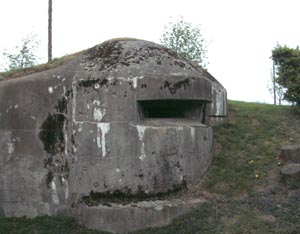Maginot Line
|
|
| Contents |
Planning and construction
The defences were first proposed by Marshal Joffre. He was opposed by modernists such as Paul Reynaud and Charles de Gaulle who favoured investment in armour and aircraft. Joffre had support from Pétain and there were a number of reports and commissions organised by the government.
The line was built in a number of phases from 1930 by the STG (Section Technique du Génie) overseen by CORF (Commission d'Organisation des Régions Fortifiées). The main construction was largely completed by 1935 at a cost of around 3 billion francs.
Features
The specification of the defenses was very high, with extensive and interconnected bunker complexes for thousands of men, there were 108 main forts (ouvrages) at 15 kilometre intervals, smaller ouvrages and casements between with over 100 kilometres of tunnels.
The fortifications did not extend through the Ardennes Forest ("impenetrable" and "impassable") or along the border with Belgium because the countries had signed an alliance in 1920, by which the French army would operate in Belgium if the German forces invaded. When Belgium abrogated the treaty in 1936 and declared neutrality, the Maginot Line was quickly extended along the Franco-Belgian border, but not to the standard of the rest of the Line. There was a final flurry of construction in 1939-1940 with general improvements all along the Line. The final Line was strongest around the industrial regions of Metz, Lauter and Alsace, while other areas were in comparison only weakly guarded.
German invasion
The World War II German invasion plan of 1940 (Sichelschnitt) was designed to deal with the Line. A decoy force sat opposite the Line while a second Army Group cut through the Low Countries of Belgium and the Netherlands, as well as through the Ardennes Forest which lay north of the main French defences. Thus the Germans were able to avoid assaulting the Maginot Line directly. Attacking from May 10, the German forces were well into France within five days and they continued to advance until May 24, when they stopped near Dunkirk. By early June the German forces had cut the Line off from the rest of France and the French government was making overtures for an armistice, which was signed on June 22 in Compiègne. But the Line was still intact and manned with a number of commanders wanting to hold out; and the Italian advance had been successfully contained. Still Maxime Weygand signed the surrender and the army was ordered into captivity.
End of the war
When the Allied forces invaded in June 1944 the Line was again largely bypassed, with fighting only touching a part of the fortifications near Metz and in northern Alsace towards the end of 1944.
The Line after WWII
After the war the Line was re-manned by the French and underwent some modifications. However when France withdrew from NATO (in 1966) much of the Line was abandoned. With the rise of the French independent nuclear deterrent by 1969 the Line was largely given up by the government, with sections auctioned off to the public and the rest left to decay.
The term "Maginot Line" has been used as a metaphor for something that is confidently relied upon despite being ineffectual. In fact, it did exactly what it was intended to do, sealing off a section of France, and forcing an aggressor around it (and the few forts of the Maginot line which were directly attacked by German armoured troops held very well). As originally envisioned, the Maginot Line was part of a larger defence plan, in which the attackers would meet with resistance from the French Army, but planning in general failed, leading to the loss of effectiveness of the Line.
See also
Books
- Anthony Kemp - The Maginot Line: Myth and Reality (1982)
External link
- Maginot line (http://www.maginot-line.com/) (requires Flash plugin)de:Maginot-Linie
eo:Maginot-linio fr:Ligne Maginot id:Garis Maginot it:Linea Maginot he:קו מאז'ינו ms:Garis Maginot nl:Maginotlinie ja:マジノ線 pl:Linia Maginota pt:Linha Maginot sr:Мажино линија zh:马奇诺防线 fi:Maginot-linja

